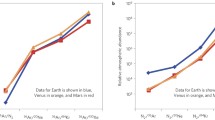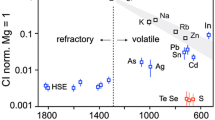Abstract
The solubility of volatile compounds in magmas and the redox state of their mantle source are the main factors that control the transfer of volatile components from the planet’s interior to its surface. In theories of the formation of the Earth, the composition of gases extracted by primary planetary magmas is accounted for by the large-scale melting of the early mantle in the presence of the metallic Fe phase [1, 2]. The fused metallic Fe phase and the melted silicate material experienced gravitational migration that exerted influence upon the formation of the metallic core of the planet. The large-scale melting of the early Earth should have been accompanied by the formation of volatile compounds, whose composition was controlled by the interaction of H and C with silicate and metallic melts, a process that remains largely unknown as of yet.
Similar content being viewed by others
References
G. W. Wetherill, “Formation of the Earth,” Annu. Rev. Earth Planet. Sci. 18, 205–256 (1990).
M. J. Walter, H. E. Newsom, W. Ertel, and A. Holzheid, “Silicate Partitioning and Implications for Core Formation,” in Origin of the Earth and Moon, Ed. by R. M. Canup and K. Righter (Univ. Arizona Press, Tucson, 2000), pp. 265–289.
M. Javoy, “The Integral Enstatite Chondrite Model of the Earth,” Geophys. Rev. Lett. 22, 2219–2222 (1995).
Y. Abe, E. Ohtani, T. Okuchi, et al., “Water in the Early Earth,” in Origin of the Earth and Moon, Ed. by R. M. Canup and K. Righter (Univ. Arizona Press, Tucson, 2000), pp. 413–433.
T. C. Owen and A. Bar-Nun, “Volatile Contributions from Icy Planetesimals,” in Origin of the Earth and Moon, Ed. by R. M. Canup and K. Righter (Univ. Arizona Press, Tucson, 2000), pp. 459–471.
C. Hayashi, K. Nakazawa, and Y. Nacagawa, “Formation of the Solar System,” in Protostars and Planets II, Ed. by D. C. Black and M. S. Matthons (Univ. Arizona Press, Tucson, 1985), pp. 1100–1153.
H. Wanke and G. Dreibus, “Chemistry and Accretion of Earth and Mars, ” LPC XV, 884–885 (1984).
D. Porcelli and R. O. Pepin, “Rare Gas Constraints on Early Earth History,” in Origin of the Earth and Moon, Ed. by R. M. Canup and K. Righter (Univ. Arizona Press, Tucson, 2000), pp. 435–458.
Y. Abe, “Physical State of Very Early Earth,” Lithos 30, 223–235 (1993).
S. Sasaki, “The Primary Solar-Type Atmosphere Surrounding the Accreting Earth: H2O-Induced High Surface Temperature,” in Origin of the Earth, Ed. by H. E. Newsom and J. H. Jones (Oxford Univ., New York, 1990), pp. 195–209.
E. M. Galimov, Life Phenomenon: between Equilibrium and Non-Linearity. Origin and Principles of Evolution (URSS, Moscow, 2001) [in Russian].
A. A. Kadik, F. Pineau, Y. A. Litvin, et al., “Formation of Carbon and Hydrogen Species in Magmas at Low Oxygen Fugacity during Fluid-Absent Melting of Carbon-bearing Mantle,” J. Petrol. 45 (7), 1297–1310 (2004).
I. D. Ryabchikov, D. Green, V. Wall, and D. Brey, “Oxidation State of Carbon in the Low-Velocity Zone,” Geokhimiya, No. 2, 221–232 (1981).
R. J. Arculus, “Oxidation Status of the Mantle: Past and Present,” Annu. Rev. Earth Planet. Sci. 13, 75–95 (1985).
W. R. Taylor, and D. H. Green, “The Petrogenetic Role of Methane: Effect on Liquidus Phase Relations and the Solubility Mechanism of Reduced C-H Volatiles,” in Magmatic Processes: Physicochemical Principles, Ed. by B. O. Mysen, Geochem. Soc. Spec. Publ. 1, 121–138 (1987).
C. Ballhaus, “Redox States of Lithospheric and Asthenospheric Upper Mantle,” Contrib. Mineral. Petrol. 114, 331–348 (1993).
J. F. Kasting, D. H. Eggler, and S. P. Raenburn, “Mantle Redox Evolution and Oxidation State of the Archean Atmosphere,” J. Geol. 101, 245–257 (1993).
A. A. Kadik, “Evolution of Earth’s Redox State during Upwelling of Carbon-Bearing Mantle,” Phys. Earth Planet. Int. 100, 157–166 (1997).
E. M. Galimov, “Growth of the Earth’s Core as a Source of Its Internal Energy and a Factor of Mantle Redox Evolution,” Geokhimiya, No. 8, 755–758 (1998) [Geochem. Int. 36 (8), 673–675 (1998)].
L. N. Kogarko, “Alkaline Magmatism in the Early History of the Earth,” Petrologiya 6 (3), 251–258 (1998) [Petrology 6 (3), 230–236 (1998)].
M. Javoy, “The Major Volatile Elements of the Earth: Origin, Behavior, and Fate,” Geophys. Rev. Lett. 24, 177–180 (1997).
M. Javoy, “The Birth of the Earth’s Atmosphere: The Behavior and Fate of the Major Elements,” Chem. Geol. 147, 11–25 (1998).
B. J. Wood, L. T. Bryndzia, and K. E. Johnson, “Mantle Oxidation State and Its Relationship to Tectonic Environment and Fluid Speciation,” Science 248, 337–345 (1990).
H. Wanke, “Constitution of Terrestrial Planets,” Phil. Trans. R. Soc. London A303, 287–302 (1981).
C. J. Allegre, J.-P. Poirier, E. Hulmer, and A. W. Hofman, “The Chemical Composition of the Earth,” Earth Planet. Sci. Lett. 134, 515–526 (1995).
D. H. Eggler and D. Baker, “Reduced Volatiles in the System C-O-H: Implications to Mantle Melting, Fluid Formation, and Diamond Genesis,” in: High Pressure Research in Geophysics, Ed. by S. Akimoto and M. Manghnani (Jpn. Cent. Acad. Public., Tokyo, 1982), pp. 237–250.
J. R. Holloway and S. Jakobsson, “Volatile Solubilities in Magmas: Transport of Volatiles from Mantles to Planet Surface,” J. Geophys. Res. 91 (B4), D505–D508 (1986).
N. I. Bezmen, V. A. Zharikov, M. B. Epelbaum, et al., “The System NaAlSi3O8-H2O-H2 (1200°C, 2 kbar): The Solubility and Interaction Mechanism of Fluid Species with Melt,” Contrib. Mineral. Petrol. 109, 89–97 (1991).
A. Kadik, F. Pineau, Y. Litvin, et al., “Formation of Carbon and Hydrogen Species in Magmas at Low Oxygen Fugacity,” UK J. Conf. Abstracts 5 (2), 564 (2000).
Yu. A. Litvin, “On the Procedure for the High-Pressure Studies of Phase Equilibria with Iron-bearing Magmatic Melts,” Geokhimiya, No. 8, 1234–1242 (1981).
S. R. Bohlen and A. L. Boettcher, “The Quartz-Coesite Transformation: A Precise Determination and the Effects of Other Components,” J. Geophys. Res. 87, 7073 (1982).
P. Ulmer and R. W. Luth, “The Graphite-COH Fluid Equilibrium in P, T, fO2 Space: An Experimental Determination to 30 kbar and 1600°C,” Contrib. Mineral. Petrol. 106, 265 (1991).
I-Ming Chou, “The Oxygen Buffer and Hydrogen Sensor Techniques at Elevated Pressures and Temperatures,” in Hydrothermal Experimental Techniques, Ed. by G. C. Ulmer and H. L. Barens (Wiley, New York, 1987), pp. 61–99.
G. C. Ulmer, D. E. Grandstaff, E. Woermann, et al., “The Redox Stability of Moissanite (SiC) Compared with Metal-Metal Oxide Buffer at 1773 K and at Pressure up to 90 kbar,” Neues. Jahrb. Mineral. Abh. 172 (2/3), 279–307 (1998).
J. R. Holloway, “Volatile Interactions in Magmas,” in Thermodynamics of Minerals and Melts, Ed. by R. S. Newton, A. Navrotsky, and B. J. Wood, Adv. Phys. Geochem. 1, 273–293 (1981).
A. A. Ariskin, A. A. Borisov, and G. S. Barmina, “Modeling of the Iron-Silicate Melt Equilibrium in Basaltic Systems,” Geokhimiya, No. 9, 1231–1240 (1992).
E. Stolper, “The Speciation of Water in Silicate Melts,” Geochim. Cosmochim. Acta 46, 2609–2620 (1982).
S. Newman, E. M. Stolper, and S. Epstein, “Measurement of Water in Rhyolitic Glasses: Calibration of an Infrared Spectroscopic Technique,” Am. Mineral. 71, 1527–1541 (1986).
E. M. Dianov, M. M. Bubnov, A. N. Gurianov, et al., “Phosphosilicate Glass Optical Fibers: A Promising Material for Raman Lasers,” in Proceedings of ECOC 2000, September 3–7, 2000 (Germany, Munich, 2000), Vol. 3, pp. 135–136.
G. Fine and E. Stolper, “The Speciation of Carbon Dioxide in Sodium Aluminosilicate Glasses,” Contrib. Mineral. Petrol. 91, 105–121 (1985).
C. G. Pouchert, The Aldrich Library of Infrared Spectra, 3rd ed. (Aldrich Chemical Co, 1981).
R. Cataliotti and R. N. Jones, “Further Evidence of Fermi Resonance in the C-O Stretching Band of Cyclopentanone,” Spectrochim. Acta 27A, 2011–2013 (1971).
B. O. Mysen and D. Virgo, “Volatiles in Silicate Melts at High Pressure and Temperature: 2. Water in Melts along the Join NaAlO2-SiO2 and a Comparison of Solubility Mechanisms of Water and Auorine,” Chem. Geol. 57, 333–358 (1986).
R. W. Luth, B. O. Mysen, and D. Virgo, “Raman Spectroscopic Study of the Solubility Behavior of H2 in the System Na2O-Al2O3-SiO2-H2,” Am. Mineral. 72, 481–486 (1987).
D. R. Neuville and B. O. Mysen, “Role of Aluminum in the Silicate Network: In Situ, High-temperature Study of Glasses and Melts on the Joint SiO2-NaAlO2,” Geochim. Cosmochim. Acta 60, 1727–1737 (1996).
B. O. Mysen, “Interaction between Aqueous Fluid and Silicate Melt in the Pressure and Temperature Regime of the Earth’s Crust and Upper Mantle,” Neues Jahrb. Mineral. Abh. 172 (2/3), 227–244 (1998).
A. Debernardi, C. Ulrich, K. Syassen, and M. Cardona, “Raman Linewidths of Optical Phonons in 3C-SiC under Pressure: First-Principles Calculations and Experimental Results,” Phys. Rev., No. 10, 6774–6783 (1999).
P. Lespade, R. Al-Jishi, and M. S. Dresselhaus, “Model for Raman Scattering from Incompletely Graphitized Carbons,” Carbon 5, 427–431 (1982).
J. N. Rouzaud, A. Oberelin, and C. Beny-Baddez, “Carbon Films Structure and Microtexture (Optical and Electron Microscopy, Raman Spectroscopy),” Thin Solid Films 105, 75–96 (1983).
A. V. Sobolev and M. Chaussidon, “H2O Concentrations in Primary Melts from Supra-Subduction Zones and Mid-Oceanic Ridges: Implications for H2O Storage and Recycling in the Mantle,” Earth Planet. Sci. Lett. 137, 45–55 (1996).
J. R. Holloway, “Graphite-Melt Equilibria during Mantle Melting: Constraints on CO2 in MORB Magmas and the Carbon Content of the Mantle,” Chem. Geol. 147, 89–97 (1998).
Author information
Authors and Affiliations
Additional information
Original Russian Text © A.A. Kadik, Yu.A. Litvin, V.V. Koltashev, E.B. Kryukova, V.G. Plotnichenko, 2006, published in Geokhimiya, 2006, No. 1, pp. 38–53.
Rights and permissions
About this article
Cite this article
Kadik, A.A., Litvin, Y.A., Koltashev, V.V. et al. Solubility of hydrogen and carbon in reduced magmas of the early Earth’s mantle. Geochem. Int. 44, 33–47 (2006). https://doi.org/10.1134/S0016702906010058
Received:
Issue Date:
DOI: https://doi.org/10.1134/S0016702906010058




